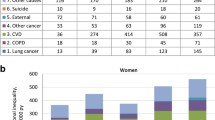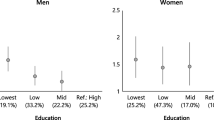Abstract
This study examines the association between education and mortality from specific causes of death based on mortality records for 1996 and 1997, and 1996 population census data from the Region of Madrid (Spain). Poisson regression models were used to estimate the percentage increase in mortality associated with 1 year less education. The percentage increases in mortality from stomach cancer, lung, bladder and liver cancers, for aids, chronic obstructive pulmonary disease, pneumonia and influenza, and chronic liver disease and cirrhosis were higher in men than in women, whereas the percentage increases in mortality from colon cancer, diabetes mellitus, ischemic heart disease and nephritis, nephrosis and nephrotic syndrome were higher in women. The results found for some causes of death – lung cancer, ischemic heart disease, diabetes mellitus and chronic obstructive pulmonary disease – reflect the variations by educational level in the prevalence of lifestyle-related risk factors in men and women. Various hypotheses have been suggested for other causes of death, but it is not known why the magnitude of the association between education and mortality from some causes of death differs between men and women. Future studies of this subject may provide some clues as to the underlying mechanisms of this association.
Similar content being viewed by others
References
Blane D, Davey Smith G, Barley M. Social class differences in years of potential life lost: size, trends, and principal causes. Br Med J 1990; 301: 429–432.
Valkonen T, Martelin T, Rimpelaä A, Notjola V, Savela S. Socioeconomic differences in Finland 1981-1990. Helsinki: Central Statistical Office of Finland, 1993.
Sorlie PD, Backlund E, Keller JB. US mortality by economic, demographic, and social characteristics: The National Longitudinal Mortality Study. Am J Public Health 1995; 85: 949–956.
Mackenbach JP, Kunst AE, Cavelaars AEJM, Groenhof F, Geurts JJM, the EU Working Group on Socioeconomic Inequalities in Health. Socioeconomic inequalities in morbidity and mortality in Western Europe. Lancet 1997; 349: 1655–1659.
Stronks K, van de Mheen H, van den Bos J, Mackenbach JP. Smaller socioeconomic inequalities in health among women: The role of employment status. Int J Epidemiol 1995; 24: 559–568.
Koskinen S, Martelin T. Why are socioeconomic mortality differences smaller among women than among men? Soc Sci Med 1994; 38: 1385–1396.
Mackenbach JP, Kunst AE, Groenhof F, et al. Socioeconomic inequalities in mortality among women and men: An international study. Am J Public Health 1999; 89: 1800–1806.
Regidor E, Calle ME, Domínguez V, Navarro P. Inequalities in mortality in shrinking and growing areas. J Epidemiol Community Health 2002; 56: 919–921.
Clayton D, Hills M. Statistical Models in Epidemiology. Oxford: Oxford University Press, 1993, pp. 249–260.
Instituto de Estadística de la Comunidad de Madrid. Estadística de Població n de la Comunidad de Madrid, 1996. Tomo II: Estudios y actividad económica de la población. Madrid: Consejería de Hacienda; 1998.
Hosmer DW, Lemeshov S. Applied Logistic Regression. New York: John Wiley Sons, 1989, pp. 56–58.
Shouls S, Congdon P, Curtis S. Modelling inequality in reported long term illness in the UK: Combining individual and area characteristics. J Epidemiol Commun Health 1996; 50: 366–376.
Diez Roux AV, Merkin SS, Arnett D, et al. Neighborhood of residence and incidence of coronary heart disease. N Engl J Med 2001; 345: 99–106.
Regidor E, Calle ME, Domínguez V, Navarro P. Mortalidad según características sociales y económicas: Estudio de Mortalidad de la Comunidad Autónoma de Madrid. Med Clin (Barc) 2001; 116: 726–731.
Doll R, Peto R, Wheatley K, Gray R, Sutherland I. Mortality in relation to smoking: 40 years' observations on male British doctors. Br Med J 1994; 309: 901–911.
Regidor E, Gutiérrez-Fisac JL, Rodríguez C. Diferencias y desigualdades en salud en España. Madrid: Díaz de Santos, 1994.
Navarro V, Benach J y la Comisión Científica de estudios de las desigualdades sociales en salud en España. Desigualdades sociales en salud en España. Madrid: Ministerio de Sanidad y Consumo y The School of Hygiene and Public Health, The Johns Hopkins University, 1996.
Cavelaars AEJM, Kunst AE, Geurts JJM, et al. Educational differences in smoking: International comparison. Br Med J 2000; 320: 1102–1107.
Forman D, Goodman KJ. The epidemiology of stomach cancer: Correlating the past with the present. Br Med J 2000; 320: 1682–1683.
Potter JD, Slattery ML, Bostick RM, Gapstur SM. Colon cancer: A review of epidemiology. Epidemiol Rev 1993; 15: 499–545.
Hsieh C, Tzonou A, Zavitsanos X, Kaklamni E, Lan S, Trichopoulos D. Age at first establishment of chronic hepatitis B virus infection and hepatocelular carcinoma risk. Am J Epidemiol 1992; 136: 1115–1121.
Willet WC, Trichopoulos D. Nutrition and cancer: A summary of the evidence. Cancer Causes Control 1996; 7: 178–180.
Gutiérrez-Fisac JL, Regidor E, Rodríguez C. Trends in obesity differences by educational level in Spain. J Clin Epidemiol 1996; 49: 351–354.
Gutierrez-Fisac JL, Banegas Banegas JR, Rodríguez Artalejo F, Regidor E. Increasing prevalence of overweight and obesity among Spanish adults, 1987-1997. Int J Obesity 2000; 24: 1677–1682.
Stuver SO, Boschi-Pinto C, Trichopoulos D. Infection with hepatitis B and C viruses, social class and cancer. In: Kogevinas M, Susser M, Boffetta P (eds), Social Inequalities and Cancer, Lyon: IARC Scientific Publicatons No. 138, 1997; 319–324.
Regidor E, Gutiérrez-Fisac JL. Health Indicators. Fourth Evaluation in Spain of the European Regional Health for All Programme. Madrid, Ministerio de Sanidad y Consumo, 1999; 215–220.
CDC. Chronic disease reports: Deaths from diabetes - Unites States, 1986. MMWR 1989; 38: 543–546.
Eckardt MJ, Harfod TC, Kaelber CT, et al. Health hazards associated with alcohol consumption. JAMA 1981; 246: 648–666.
Author information
Authors and Affiliations
Rights and permissions
About this article
Cite this article
Regidor, E., Calle, M.E., Navarro, P. et al. The size of educational differences in mortality from specific causes of death in men and women. Eur J Epidemiol 18, 395–400 (2003). https://doi.org/10.1023/A:1024296932294
Issue Date:
DOI: https://doi.org/10.1023/A:1024296932294




